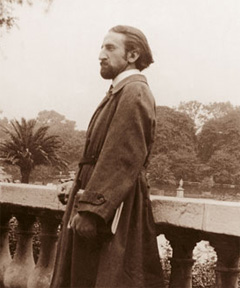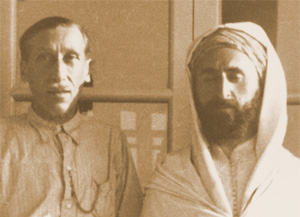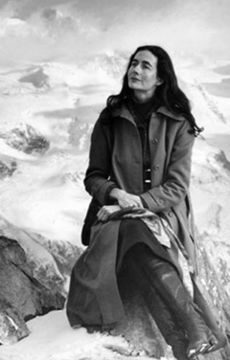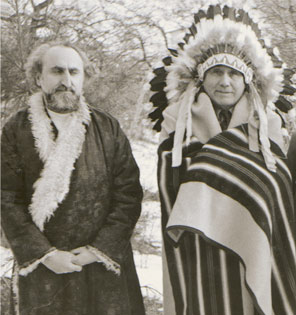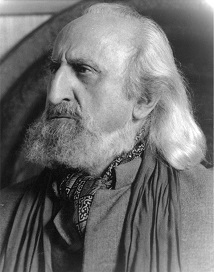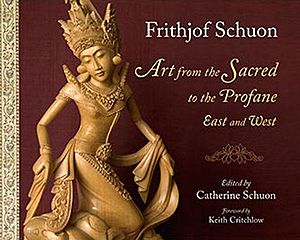Frithjof Schuon facts for kids
Quick facts for kids
Frithjof Schuon
|
|
|---|---|

Frithjof Schuon, c. 1980
|
|
| Born | 18 June 1907 |
| Died | 5 May 1998 (aged 90) Bloomington, Indiana, U.S.A.
|
| Nationality |
|
|
Notable work
|
|
| School | Perennial philosophy Traditionalist School |
|
Main interests
|
Metaphysics, esoterism, philosophy, spirituality, religion, art |
|
Influences
|
|
|
Influenced
|
|
| Signature | |
Frithjof Schuon (frit-jof_shoo-on, /ˈʃuːɒn/, German: [ˈfʁɪtjɔf ˈʃuːɔn]; 18 June 1907 – 5 May 1998) was a Swiss metaphysician of German descent, belonging to the Perennialist or Traditionalist School of thought. He was the author of more than twenty works in French on metaphysics, spirituality, the religious phenomenon, anthropology and art, which have been translated into English and many other languages. He was also a painter and a poet.
With René Guénon and Ananda Coomaraswamy, Schuon is recognized as one of the major 20th-century representatives of the philosophia perennis. Like them, he affirmed the reality of an absolute Principle – God – from which the universe emanates, and maintained that all divine revelations, despite their differences, possess a common essence: one and the same Truth. He also shared with them the certitude that man is potentially capable of supra-rational knowledge, and undertook a sustained critique of the modern mentality severed, according to him, from its traditional roots. Following Plato, Plotinus, Adi Shankara, Meister Eckhart, Ibn Arabī and other metaphysicians, Schuon sought to affirm the metaphysical unity between the Principle and its manifestation.
Initiated by Sheikh Ahmad al-Alawī into the Sufi Shādhilī order, he founded the Tarīqa Maryamiyya. His writings strongly emphasize the universality of metaphysical doctrine, along with the necessity of practising a religion; he also insists on the importance of the virtues and of beauty.
Schuon cultivated close relationships with a large number of personages of diverse religious and spiritual horizons. He had a particular interest in the traditions of the North American Plains Indians, maintaining firm friendships with a number of their leaders and being adopted into both a Lakota Sioux tribe and the Crow tribe. Having spent a large part of his life in France and Switzerland, at the age of 73 he emigrated to the United States.
Life and work
Basel, Switzerland (1907–1920)
Frithjof Schuon was born in Basel, in the German-speaking part of Switzerland, on 18 June 1907. He was the younger of the two sons of Paul Schuon, who was of German origin, and Margarete Boehler, a French-speaking Alsatian. His father, an amiable and distinguished man, was a concert violinist, and the household was one in which not only music but literary and spiritual culture were present. The Schuons, though Catholics, enrolled their sons in the Lutheran catechism, the predominant denomination in Basel.
At primary school, Schuon met the future metaphysician and art specialist Titus Burckhardt, who remained a lifelong friend. From the age of ten, his search for truth led him to read not only the Bible but also the Upanishads, the Bhagavad-Gītā and the Quran, as well as Plato, Emerson, Goethe and Schiller. Schuon would later say that in his early youth four things had always moved him most profoundly: "the holy, the great, the beautiful, the childlike".
France (1920–1940)
In 1920, Schuon's father died and his mother decided to return with her young sons to her family in nearby Mulhouse, France, where Schuon became a French citizen, consequent upon the Treaty of Versailles. One year later, when he was 14, he was baptized as a Catholic. In 1923 his brother entered a Trappist monastery, and Schuon left school in order to provide for the family, finding work as a textile designer.
He then immersed himself in the world of the Bhagavad-Gītā and the Vedānta; this call of Hinduism sustained him for ten years, though he was perfectly aware that he could not become Hindu himself. In 1924, while still living in Mulhouse, he discovered the works of the French philosopher René Guénon, which served to confirm his intellectual intuitions and provided support for the metaphysical principles he had begun to discover. Schuon would later say of Guénon that he was "the profound and powerful theoretician of all that he loved".
In 1930, after 18 months in Besançon on military service in the French army, Schuon settled in Paris. There he resumed his profession as a textile designer, and began to study Arabic in the local mosque school. Living in Paris also gave him the opportunity to be exposed to various forms of traditional art to a much greater degree than before, especially the arts of Asia with which he had had a deep affinity since his youth.
At the end of 1932 he completed his first book, Leitgedanken zur Urbesinnung, which would be published in 1935 and later translated into English under the title Primordial Meditation: Contemplating the Real. His desire to leave the West, whose modern values were so contrary to his nature, combined with his growing interest in Islam, prompted him to go to Marseilles, the great port of departure for the East. There he made the acquaintance of two key personages, both of them disciples of Sheikh Ahmad al-Alawī, a Sufi in Mostaganem, Algeria. Schuon saw the sign of his destiny in these encounters, and embarked for Algeria. In Mostaganem he entered Islam, and spent nearly four months in the Sheikh's zāwiya. The Sheikh gave him initiation and named him `Īsā Nūr ad-Dīn. However, Schuon was soon forced to return to Europe under pressure from the French colonial authorities.
Schuon did not consider his affiliation to Islam as a conversion, since he did not disavow Christianity; in each revelation he saw the expression of one and the same truth, in different forms. But for him, Christianity no longer offered the possibility of following a "path of knowledge" under the guidance of a spiritual master, whereas such a path still exists in Sufism, Islamic esoterism.
Schuon reported that one night in July 1934, while immersed in reading the Bhagavad-Gītā, he experienced an extraordinary spiritual event. He said that the divine Name Allāh took possession of his being, and that for three days he could do nothing but invoke it ceaselessly. Shortly afterwards, he learned that his Sheikh had died on the same day.
In 1935 he returned to the zāwiya of Mostaganem, where Sheikh Adda ben Tounes, Sheikh al-Alawī's successor, conferred on him the function of muqaddam, thus authorizing him to initiate aspirants into the Alawī brotherhood. Returning to Europe, Schuon founded a zāwiya in Basel, another in Lausanne and a third in Amiens. He resumed his profession as a textile designer in Alsace for the next four years.
One night towards the end of 1936, after a spiritual experience, Schuon sensed, without a shadow of a doubt, that he had been invested with the function of spiritual master, of sheikh. This was confirmed, he later related, by visionary dreams that several of his disciples reported having had the same night. The differences of perspective between Schuon and the Mostaganem zāwiya gradually led to Schuon's assuming independence, supported by Guénon.
In 1938, Schuon traveled to Egypt, where he met Guénon, with whom he had been in correspondence for 7 years. In 1939, he embarked for India with two disciples, making a long stopover in Cairo, where he saw Guénon again. Shortly after his arrival in Bombay, World War II broke out, forcing him to return to Europe. Serving in the French army, he was interned by the Nazis, who were planning to incorporate all soldiers of Alsatian origin into the German army to fight on the Russian front. Schuon escaped to Switzerland, which was to be his home for forty years.
Lausanne, Switzerland (1941–1980)
He settled in Lausanne, where he continued contributing to the Guénonian journal Études Traditionnelles, as he had done since 1933. In 1947, after reading Black Elk Speaks by John G. Neihardt, Schuon, who had always been deeply interested in the North American Indians, was convinced that Black Elk knew much more about Sioux tradition than was contained in the book. He asked his American friends to seek out the old chief. Following this initiative, the ethnologist Joseph E. Brown collected from Black Elk the description of the seven Sioux rites which would form the content of The Sacred Pipe.
In 1948 Schuon published his first book in French, De l'Unité transcendante des religions. Of this book, T. S. Eliot wrote: "I have met with no more impressive work in the comparative study of Oriental and Occidental religion." All his subsequent works – more than twenty – would be written in French, apart from a major reworking in German of the text of The Transcendent Unity of Religions (Von der Inneren Einheit der Religionen), published in 1982.
In 1949 Schuon married Catherine Feer, a German Swiss with a French education who, besides being deeply interested in religion and metaphysics, was also a gifted painter. He received Swiss citizenship shortly after his marriage. While always continuing to write, Schuon and his wife travelled widely. Between 1950 and 1975, the couple visited Morocco about ten times, as well as numerous European countries, including Greece and Turkey, where they visited the house near Ephesus presumed to be the last home of the Virgin Mary.
In the winter of 1953, Schuon and his wife travelled to Paris to attend performances organized by a group of Crow dancers. They formed a friendship with Thomas Yellowtail, the future medicine man and Sun Dance Chief. Five years later, the Schuons visited the Brussels World's Fair, where 60 Sioux were giving performances on the theme of the Wild West. New friendships were made on this occasion also.
Thus it was that in 1959 and again in 1963, at the invitation of their Indian friends, the Schuons journeyed to the American West, where they visited various Plains tribes and had the opportunity to witness many aspects of their sacred traditions. During the first of these visits, Schuon and his wife were adopted into the Sioux family of Chief James Red Cloud, grandson of Chief Red Cloud, and a few weeks later, at an Indian festival in Sheridan, Wyoming, they were officially received into the Sioux tribe. Schuon's writings on the central rites of Native American religion and his paintings of their way of life attest to his particular affinity with their spiritual universe.
The 1970s saw the publication of three important works composed of articles previously published in the French journal Études Traditionnelles. These works have been translated under the titles:
- Logic and Transcendence, in which the author examines modern philosophy, the proofs of God, universal Substance, emanationism and creationism, intellect and sentiment, the qualifications for the spiritual path, the love of God, spiritual realization, the spiritual master, beauty, intelligence, certitude;
- Form and Substance in the Religions: Truth and divine Presence, the religions, Ātmā and Māyā, the degrees of reality, elucidations concerning the Koran and the Prophet, the Virgin Mary, the virtues and women in Buddhism, the two natures of Christ, evil and the divine Will, sacred texts, spiritual dialectic, paradise and hell;
- Esoterism as Principle and as Way: exoterism and esoterism, the universal veil, the hypostatic dimensions of the Principle, the Tree of Life, human nature, the virtues, sentiment, sincerity, trials, spiritual realization, beauty, art, the importance of forms, relics, celestial apparitions, the Sun Dance, spiritual inwardness in Sufism.
Throughout his life, Schuon had great respect for and devotion to the Virgin Mary, and expressed this in his writings. As a result, his teachings and paintings are imbued with a particular Marian presence. His reverence for the Virgin Mary has been studied in detail by American professor James Cutsinger, who relates the two episodes in 1965 when Schuon experienced an especial Marian grace. Hence the name Maryamiyya ("Marian" in Arabic) of the Sufi tarīqa he founded as a branch of the Alawiyyah-Darqawiyyah-Shadhiliyyah order.
United States (1980–1998)
In 1980, Schuon and his wife emigrated to the United States, settling in Bloomington, Indiana, where there was already a large community of disciples. The first years in Bloomington saw the publication of a number of important works including From the Divine to the Human, To Have a Center, Survey of Metaphysics and Esoterism, and Roots of the Human Condition.
According to Patrick Laude, Schuon became known, through his many books, articles and letters, "as the principal spokesman of the intellectual current sometimes referred to in English speaking countries as perennialism", or the Traditionalist School. During his years in Lausanne and Bloomington he regularly received visits from "practitioners and representatives of diverse religions".
Thomas Yellowtail remained Schuon's intimate friend until his death in 1993, visiting him every year and adopting him into the Crow tribe in 1984. During these sojourns, Schuon and some of his followers organized what they called "Indian Days", in which Native American dances were performed. These gatherings were understood by disciples as a sharing in Schuon's personal insights and realization, not as part of the initiatic method he transmitted, centered on Islamic prayer and the dhikr.
In 1991, one of Schuon's followers accused him of misconduct during collective gatherings. A preliminary investigation was begun, but the chief prosecutor concluded that there was no proof, noting that the plaintiff was of extremely dubious character and had been previously condemned for making false statements in another similar affair in California. The prosecutor declared that there were no grounds for prosecution, and the local press made amends. Some articles and books, including Mark Sedgwick's Against the Modern World, discuss this event and the related "primordial" practices of the Bloomington community in Midwestern suburban America in the late twentieth century.
Schuon continued to receive visitors and maintain a correspondence with followers, scholars and readers. At the very end of his life, he wrote a major collection of over three thousand lyrical "teaching-poems" (Sinngedichte or Lehrgedichte), which combine metaphysics and spiritual counsel, as well as reminiscences of his life. Like the poems of his youth, these were written in his native German, following a series in Arabic and another in English. They are a poetic synthesis of his philosophical and spiritual message, which is articulated around four key elements: "truth, prayer, virtue and beauty". Less than two months before his death on May 5, 1998 at the age of 90, Frithjof Schuon wrote his last poem:
Ich wollte dieses Buch schon lang beschließen –
Ich konnte nicht; ich musste weiter dichten.
Doch diesmal legt sich meine Feder nieder,
Denn es gibt andres Sinnen, andre Pflichten;
Wie dem auch sei, was wir auch mögen tun:
Lasst uns dem Ruf des Höchsten Folge leisten –
Lasst uns in Gottes tiefem Frieden ruhn.
Das Weltrad VII, CXXX
I have for long wished to end this book —
I could not do so; I had to write more poems.
But this time my pen lies down of itself,
For there are other preoccupations, other duties;
Be that as it may, whatever we may wish to do:
Let us follow the call of the Most High —
Let us repose in God’s deep Peace.
World Wheel VII, CXXX
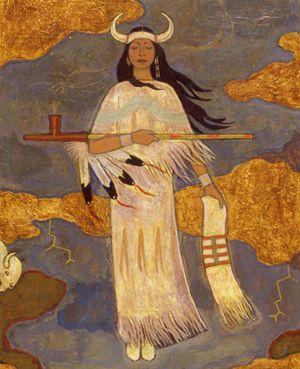
oil painting by F. Schuon, 1959
Views based on his written works
For Seyyed Hossein Nasr, Schuon is at once "metaphysician, theologian, traditional philosopher and logician", versed in "comparative religion", in "traditional art and civilization", as well as in "the science of man and society"; he is also known as "a critic of the modern world in not only its practical but also its philosophical and scientific aspects". In his writings, Schuon's principal themes are "essential and hence universal metaphysics with its cosmological and anthropological ramifications, spirituality in the broadest sense, intrinsic morals and aesthetics, traditional principles and phenomena", religions and their esotericisms, sacred art.
Doctrinal foundation
Perennialism
The traditionalist or perennialist spiritual perspective was initially enunciated in the 1920s by René Guénon and in the 1930s by Frithjof Schuon. The metaphysicians and art specialists Ananda Coomaraswamy and Titus Burckhardt also became prominent advocates of this intellectual current. According to the perennialist writer William Stoddart, "the central idea of the perennial philosophy is that Divine Truth is one, timeless and universal, and that the different religions are but different languages expressing that one Truth" – hence the title given by Schuon to his first book in French, De l'unité transcendante des religions. For Patrick Laude, a perennialist author is "one who claims the universality and primordiality of fundamental metaphysical principles and the perennity of the wisdom that actualizes these principles in man, as expressed in all great revelations and major teachings of sages and saints throughout the ages".
According to Harry Oldmeadow, this primordial truth or wisdom has "carried many names: Philosophia Perennis, Lex Aeterna, Hagia Sophia, Dīn al-Haqq, Akālika Dhamma, Sanātana Dharma", etc. Schuon points out that primordial wisdom is expressed in the work of Adi Shankara, Pythagoras, Plato, Plotinus and several other representatives of quintessential esoterism.
For Laude, it is not the notion of the "transcendental unity of religions" that primarily characterizes Schuon's teaching, but rather "a reformulation of the sophia perennis, or religio perennis, conceived as the conjunction of a metaphysical doctrine and a means of spiritual realization".
Metaphysics
Schuon characterizes "pure" metaphysics as 1) "essential", i.e. "independent of all religious formulation"; 2) "primordial", namely "the truth that existed before all dogmatic formalism"; and 3) "universal", in that it "encompasses all intrinsically orthodox symbolism" and "can therefore be combined with any religious language". For him, pure metaphysics can be summarized by the following vedantic statement: Brahma satyam jagan mithyā jīvo brahmaiva nāparah (Brahman is real, the world is illusory, the individual soul is not different from Brahman).
The metaphysics expounded by Schuon is based on the doctrine of what the Hindu Advaita Vedānta refers to as Ātmā and Māyā. Ātmā (Ātman) is the Self, both transcendent and immanent; in correlation with Māyā, Ātmā designates the Real, the Absolute, the Principle, Beyond Being, Brahma (Brahman); and Māyā the illusory, the relative, manifestation. Schuon develops this metaphysical principle, notably in Form and Substance in the Religions, basing himself on the Sufi doctrine of the degrees of reality, known as "The Five Divine Presences":
- Degrees 1 and 2, taken together, correspond to God, the Principle, the Absolute:
1. Ātmā: Beyond-Being, Impersonal Divinity, Supreme Principle, Absolute Reality, Essence, nirguna Brahman.
- Degrees 2 to 5 correspond to Māyā:
2. Māyā in divinis (the "relative Absolute", "Ātmā as Māyā"): Being, Personal God, creating Principle, uncreated Spirit, saguna Brahman, Īshvara.
- Degrees 3 to 5 correspond to manifestation, the cosmos, creation:
3. Supra-formal manifestation: created Spirit (Intellect, Logos, Buddhi), paradise, angels.
- Degrees 4 and 5 correspond to formal manifestation:
4. Subtle or animic manifestation: the world of the soul and the "spirits" (jinns, sylphs, salamanders, gnomes, etc.).
5. Gross or material manifestation: the visible world.
In the human being (the microcosm) the five degrees, ordered inversely, correspond to the body and the sensorial, mortal soul (5); the supra-sensorial, immortal soul (4); the created spirit (or intellect) (3); the uncreated spirit (or intellect) (2); the absolute and infinite Self (1). The presence of the three superior degrees in man "made in the image of God" confers upon him the possibility of a knowledge that transcends the limitations of subjectivity, thus in principle allowing him to "see things as they are", that is, objectively: this is gnosis.
As did Plato in ancient Greece, Adi Shankara in Hinduism, Meister Eckhardt and St Gregory Palamas in Christianity and Ibn Arabī in Islam – to name some examples –, Schuon attests that the essential discernment in metaphysics is that between the Real and the non-real (the illusory), Ātmā and Māyā. He emphasizes that the Real, or Beyond Being, which is absolute and infinite, is the essence of all good (the Sovereign Good). As St Augustine reminds us, it is in the nature of the Good (Agathôn) to radiate, hence the projection of Māyā, which is simultaneously divine (Īshvara), celestial (Buddhi and Svarga) and "earthly", the latter including the domain of transmigration (samsâra). Every good offered by the world comes from the radiation of the Sovereign Good, every evil comes from Its remoteness. Mâyâ both veils and reveals God, the Absolute.
Quintessential esoterism
Most religions comprise an exoteric and an esoteric dimension. This religious esoterism is qualified as "relative" by Schuon, to differentiate it from "absolute" or "quintessential" esoterism, which is neither limited nor totally expressed by a particular religious form.
There is therefore continuity between exoterism and esoterism when the latter appears as the inner dimension of the former and consequently adopts its "language", and there is discontinuity when esoterism transcends all religion: this is the religio perennis, the timeless, essential, primordial and universal esoterism. It constitutes "the transcendent unity of religions" and is based, methodically, on one of the revelations while having as its object the one Truth common to all of them.
Sufism
For Schuon, Sufism (tasawwuf, in Arabic) – "the marrow of Islam" – is essentially "sincerity of faith". "On the doctrinal level" this sincerity arises from an "intellectual vision" which draws "from the idea of Unity its most rigorous consequences; its ultimate conclusion is not only the idea of the nothingness of the world but also that of supreme Identity". Patrick Laude underlines the distinction made by Schuon between a "quintessential", purely esoteric, Sufism and a "moderate" Sufism which, though tending towards esoterism, remains dependent on the exoteric mentality, whence a propensity to the "intensification of pious acts, emotional exteriorization, obediential zeal, and an inordinate emphasis on formal scruples and the perspective of fear". For Laude, "the most accurate and succinct definition" of quintessential Sufism – as of every other spirituality in its essential dimension – is "Schuon's fundamental doctrinal dyad, entailing discernment between the Absolute and the relative, along with the corresponding method of exclusive concentration on the Absolute".
Schuon considers that "the whole of Sufism [...] [can be] summed up in these four words: Haqq, Qalb, Dhikr, Faqr : "Truth", "Heart", "Remembrance", "Poverty".
- al-haqq (truth, reality) "coincides with the Shahādah, the twofold testimony ("lā ilāha illā Llāh, Muhammadun rasūlu Llāh: there is no god but God, Muhammad is the envoy of God"), which enounces "metaphysical, cosmological, mystical and eschatological Truth". Summarizing Schuon, Laude notes that the first testimony means theologically or exoterically that there is only one God, and metaphysically, that He is the only reality. This latter meaning – that of the Sufis – signifies for Schuon not only "that God alone is real, in contrast to the world, which, being contingent, is illusory", but also "that no existence can be situated outside God, that everything that exists 'is not other than He', otherwise the world would not exist". Laude notes that this second meaning also emerges from the second testimony, which esoterically enounces the unitive relationship between "the conditioned and the Unconditioned, the relative and the Absolute".
- al-qalb (the heart) "is the existential and intellectual centre" of the human being, "the seat of the divine Presence and thus also of metaphysical certitude", and also, more commonly, the seat of faith. "It represents the Intellect with respect to both knowledge and love" and "thanks to the miracle of immanence, it opens onto the divine Self and onto the infinitude, both extinctive and unitive, of the knowable, hence of the Real". Thus truth (al-haqq) "must not be accepted with the mind alone but with the Heart, thus with all that we are".
- al-dhikr (remembrance, mention, invocation) is for Schuon "the actualization of faith or gnosis by means of the sacramental word", whose seat is the heart. Although the word dhikr encompasses all practices directed towards God, Harry Oldmeadow emphasizes that Schuon, when he speaks of Sufism, always uses this term in its highest sense: the invocation of the name "Allāh". According to Laude, this rite – subject to authorization –, is considered by Schuon, in accordance with the Sufi tradition, to be "the central practice of tasawwuf". To the question "why invoke?", Schuon answers: "the most profound reason would no doubt be 'because I exist', for Existence is in a certain way the Word of God, by which He names Himself. God pronounces His Name in order to manifest Himself – to 'create' – in the direction of 'nothingness', and the relative being pronounces this Name in order to 'be', that is to say, to 'become once again what he is' in the direction of Reality". "The supreme Name", whatever the spiritual path practised, "is both metaphysical Truth and saving Presence".
- al-faqr (spiritual poverty) is "simplicity and purity of soul, rendering possible" the actualization of faith or gnosis "by conferring upon it the sincerity without which no act is valid". For Laude, commenting on the Schuonian perspective, al-faqr is "humility as the absence of all egocentricity and an emptiness for God." Schuon sees "spiritual virtue par excellence" in this attitude of "holy poverty" or "effacement", an attitude that implies "detachment, sobriety, patience, contentment", "resignation to the Will of God and trust in His Mercy"; it is "like an anticipation of extinction in God".
Spiritual practice
Spiritual path
According to the writer Ali Lakhani, "Schuon emphasizes that the meaning of life is nothing less than the quest for [...] God, [...] for the Truth that resides within each of us; [...] it is the return to the heart-consciousness of the Divine Presence." For Schuon, man is "a bridge between Earth and Heaven"; on the other hand, "the notion of the Absolute and the love of God constitute the very essence of [his] subjectivity; this subjectivity [...] is a proof both of [his] immortality and of God; [it] is, properly speaking, a theophany."
Schuon reminds us that religious or spiritual life offers three fundamental paths, which correspond to as many human temperaments: 1) the path of action, works, asceticism, fear (the karma-mārga or karma-yoga of Hinduism); 2) the path of love, of devotion (bhakti-mārga); and 3) the path of gnosis, of unitive contemplation (jñāna-mārga); in Sufism: makhāfah, mahabbah, ma`rifah. The first two are dualistic and exoteric, and are based on revelation, whereas the path of knowledge is monistic and esoteric, and based on intellection supported by revelation. Just as the path of love cannot do without good works and reverential fear, so the esoteric or metaphysical path cannot exclude the two other modes.
According to Schuon, the path of knowledge or of gnosis, which is present at the heart of every religion, is essentially: 1) discernment between the Real and the illusory, ātmā and māyā, nirvāna and samsāra, the Absolute and the relative, God and the world; 2) concentration on the Real, and 3) intrinsinc morality, virtue. This discernment would remain purely mental in the absence of concentration on the Real through rites and prayer, i.e. without an effective link with God, the Sovereign Good, based on an authentic piety and sufficient detachment from the ego and from the world. The way towards God, as Schuon points out, "always involves an inversion: from outwardness one must pass to inwardness, from multiplicity to unity, from dispersion to concentration, from egoism to detachment, from passion to serenity."
Schuon emphasizes that the exoteric and esoteric rites of the religion practised – and of that one alone – are the basis for the spiritual method. Prayer is its central element, for without it – and without divine grace – the heart cannot assimilate or realize what the mind has been able to grasp. Schuon recalls the three modes of prayer: personal prayer in which the worshipper opens himself spontaneously and informally to God; canonical, impersonal prayer, prescribed by his tradition; and invocatory prayer or "prayer of the heart" (japa, dhikr), which "is already a death and a meeting with God and places us already in Eternity; it is already something of Paradise and even, in its mysterious and 'uncreated' quintessence, something of God". This form of prayer is the invocation of a divine name, a sacred formula, a mantra; it reconciles the transcendence and the immanence of Truth, because if, on the one hand, Truth transcends us infinitely, the gnostic, asserts Schuon, knows that it is also "inscribed in an eternal script in the very substance of [his] spirit"; God is both the highest and the deepest, and the knowledge the realized being has of God is in reality the knowledge that God has of Himself through that being.
Virtue
In his writings, Schuon insists that the two requirements of doctrine and method would remain inoperative without a third element, virtue, since the spiritual path must necessarily integrate the three fundamental human faculties, namely intelligence (doctrine, truth, discernment), will (method, prayer, concentration) and soul (character, virtue, moral conformity). For Schuon, virtue is indeed "the initial form of spiritual union; without it, our knowing and our willing are of no use to us." For Schuon, humility, charity and veracity, that is to say effacement of the ego, gift of self and attachment to truth, are essential virtues, corresponding to the three stages of the spiritual path: purification, expansion and union. Moreover, the sense of our littleness, the sense of the sacred and piety are indispensable conditions for the blossoming of the virtues. Summarizing the author, James Cutsinger notes that perfect virtues coincide with metaphysical truths; they realize these truths existentially. In other words, as Schuon points out: "truth is necessary for the perfection of virtue, just as virtue is necessary for the perfection of truth".
Beauty
Although Schuon considers that the foundations of any spiritual path are truth, prayer and virtue, he also insists upon the importance of a fourth element: beauty. For him, the interiorization of beauty presupposes nobility of character and at the same time produces it. Its function "is to actualize in the intelligent and sensitive creature the recollection of essences, and thus to open the way to the luminous Night of the one and infinite Essence".
To the awareness of divine beauty must correspond not only inner beauty, that is to say virtues, but also the sense of outer beauty, whether in the contemplation of nature or in artistic sensibility, without forgetting the interiorizing role of a traditional home ambiance made of beauty and serenity, foreign to the whims of modernity. "Beauty, whatever use man may make of it, belongs fundamentally to its Creator, Who thereby projects into the world of appearances something of His Being." For Schuon, these considerations find their source and justification in the theomorphic nature of man, a changeless, non-evolutive nature, contrary to what modern science may think.
Developments
Criticism of modernism
Summarizing Schuon's thought, Seyyed Hossein Nasr reminds us that it was in Europe, during the Renaissance, that the "modernist" or reductionist vision of the human condition and the universe took shape, before it affected the other continents a few centuries later. By reducing man more and more to his rational and animal aspects, to the detriment of his spiritual dimension and the purpose of earthly life, modernism has influenced philosophy as much as religion, science or art. According to Schuon, its main characteristics are rationalism, which denies the possibility of a supra-rational knowledge, materialism, according to which only matter gives meaning to life, psychologism, which reduces the spiritual and the intellectual to the psychic, skepticism, relativism, existentialism, individualism, progressivism, evolutionism, scientism and empiricism, without forgetting agnosticism and atheism.
Regarding modern science, in spite of the scale of its discoveries on the physical plane, Schuon reproaches it for being "a totalitarian rationalism, which eliminates both Revelation and Intellect, and at the same time a totalitarian materialism, which ignores the metaphysical relativity of matter and the world; it does not know that the supra-sensible, which is beyond space and time, is the concrete principle of the world, and that it is consequently also at the origin of that contingent and changeable coagulation called 'matter'". Thus, still according to Schuon, the contradiction of scientism is to "want to give an account of reality without the help of this initial science that is metaphysics, thus ignoring that only the science of the Absolute gives meaning and discipline to the science of the relative". This conception of a universe which ignores as much the principle of "creative emanationism" as much as that of the "hierarchy of the invisible worlds", has engendered "that most typical offspring of the modern spirit", the theory of evolution, with its corollary: the illusion of "human progress".
Schuon's criticism extends to philosophy – "the love of wisdom" – which was originally the fact of "thinking according to the immanent Intellect and not by reason alone". It "is the science of all fundamental principles". It operates with intellectual intuition – intellection – "which perceives, and not with reason alone, which concludes", hence the abyss that separates the certainty of the sage from the opinion of the modern philosopher.
For Schuon, there are ultimately only two possibilities: "integral, spiritual civilization, implying abuses and superstitions, and fragmentary, materialistic, progressivist civilization, implying – quite provisionally – certain earthly advantages, but excluding that which constitutes the sufficient reason and final end of all human existence".
Sacred art
Along with Ananda Coomaraswamy and Titus Burckhardt, Frithjof Schuon reminds us that "sacred art is first of all the visible and audible form of Revelation and then also its indispensable liturgical vesture". This art communicates "on the one hand, spiritual truths and, on the other hand, a celestial presence". James Cutsinger emphasizes that, for Schuon, an art is sacred "not through the personal aims of the artist, but through its content, its symbolism, and its style, that is, through objective elements", which must respect the canonical rules specific to the religion of its author. The latter, according to Martyn Amugen quoting Schuon, must be "sanctified or in a state of grace" because the language of the sacred "cannot spring simply from profane tastes, nor from genius, but must proceed essentially out of religion", which "cannot be replaced, far less can it be surpassed, by human resources". Icon painters, for example, "were monks who, before setting to work, prepared themselves by fasting, prayer, confession, and communion", in order to overcome the two pitfalls that threaten every artist: "a virtuosity tending towards the outward and the superficial, and a conventionalism without intelligence and without soul".
Echoing Schuonian thought, Cutsinger notes that the various forms of sacred art have as their object the "transmission of intellectual intuitions", thus conferring "a direct aid to spirituality", and he notes that this art "is able to transmit simultaneously metaphysical truths, archetypal values, historical facts, spiritual states, and psychological attitudes".
Evoking the transition from the Middle Ages – with its Byzantine, Romanesque and primitive Gothic arts – to the Renaissance, Schuon notes that "Christian art, which formerly was sacred, symbolical, spiritual", gave way to the advent of neo-classical art, with its naturalistic and sentimental character, which only responded "to collective psychic aspirations". Amugen, referring to Schuon, reports that art, having broken with tradition, became "human, individualistic, and therefore arbitrary", infallible signs of decline, and any desire to restore its sacred character must necessarily involve abandoning individualistic relativism in order to go back to its sources, which lie in the timeless and the immutable.
Works
Philosophy (translated from French)
- The Transcendent Unity of Religions, Faber & Faber, 1953; revised edition, Harper & Row, 1975; introduction by Huston Smith, Quest Books, 1984, 1993
- Spiritual Perspectives and Human Facts, Faber & Faber, 1954; Perennial Books, 1969; new translation, Perennial Books, 1987; new translation with selected letters, World Wisdom, 2007
- Gnosis: Divine Wisdom, Perennial Books, 1959, 1978; revised, Perennial Books 1990; new translation with selected letters, World Wisdom, 2006
- Language of the Self: Essays on the Perennial Philosophy, introduction by Venkataraman Raghavan, Ganesh Madras, 1959; Select Books Bangalore, 1998; revised and augmented, World Wisdom, 1999
- Stations of Wisdom, John Murray, 1961; Perennial Books, 1980; new translation, World Wisdom, 1995, 2003
- Understanding Islam, Allen & Unwin, Penguin, Unwin Hyman, Routledge, 1963, 1964, 1965, 1972, 1976, 1979, 1981, 1986, 1989, 1993; World Wisdom, 1994, 1998, 2003; new translation with selected letters, foreword by Annemarie Schimmel, World Wisdom, 2011
- Light on the Ancient Worlds, Perennial Books, 1965; World Wisdom, 1984; new translation with selected letters, World Wisdom, 2006
- Logic and Transcendence, Harper & Row, 1975; Perennial Books, 1984; new translation with selected letters, World Wisdom, 2009
- Esoterism as Principle and as Way, Perennial Books, 1981, 1990; new translation with selected letters, World Wisdom, 2019
- Sufism, Veil and Quintessence, World Wisdom, 1981; new translation with selected letters, foreword by Seyyed Hossein Nasr, World Wisdom, 2006
- From the Divine to the Human, World Wisdom, 1982; new translation with selected letters, World Wisdom, 2013
- Castes and Races (this book's 3 chapters are also included in Language of the Self), Perennial Books, 1982; World Wisdom, 1999
- Christianity/Islam: Perspectives on Esoteric Ecumenism, World Wisdom, 1985; new translation with selected letters, World Wisdom, 2008
- Survey of Metaphysics and Esoterism, World Wisdom, 1986, 2000
- In the Face of the Absolute, World Wisdom, 1989, 1994; new translation with selected letters, World Wisdom, 2014
- The Feathered Sun: Plains Indians in Art & Philosophy, introduction by Thomas Yellowtail, World Wisdom, 1990
- To Have a Center, World Wisdom, 1990; new translation with selected letters, World Wisdom, 2015
- Roots of the Human Condition, introduction by Patrick Laude, World Wisdom, 1991, 2002
- The Play of Masks, World Wisdom, 1992
- The Transfiguration of Man, World Wisdom, 1995
- The Eye of the Heart, foreword by Huston Smith, World Wisdom, 1997; new translation with selected letters, World Wisdom, 2021
- Form and Substance in the Religions, World Wisdom, 2002
- Primordial Meditation: Contemplating the Real, The Matheson Trust, 2015 (translated from the German)
Poetry
written in English
- The Garland, Abodes, 1994
- Road to the Heart, World Wisdom, 1995
translated from German
- Adastra & Stella Maris, foreword by William Stoddart, bilingual, World Wisdom, 2003
- Songs Without Names, Vol. I-VI, introduction by William Stoddart, foreword by Annemarie Schimmel, World Wisdom, 2006
- Songs Without Names, Vol. VII-XII, introduction by William Stoddart, foreword by Annemarie Schimmel, World Wisdom, 2006
- World Wheel, Vol. I-III, introduction by William Stoddart, foreword by Annemarie Schimmel, World Wisdom, 2006
- World Wheel, Vol. IV-VII, introduction by William Stoddart, foreword by Annemarie Schimmel, World Wisdom, 2006
- Autumn Leaves & The Ring, introduction by Patrick Laude, bilingual, World Wisdom, 2010
written in German (no translation)
- Sulamith, Urs Graf, 1947
- Tage- und Nächtebuch, Urs Graf, 1947
- Liebe / Leben / Glück / Sinn, 4 vol., Herder, 1997
Paintings
- The Feathered Sun: Plains Indians in Art & Philosophy, introduction by Thomas Yellowtail, World Wisdom, 1990
- Images of Primordial & Mystic Beauty: Paintings by Frithjof Schuon, Abodes/World Wisdom, 1992
Anthologies of Schuon's writings
- Treasures of Buddhism (formerly In the Tracks of Buddhism, Allen & Unwin, 1968; Unwin Hyman, 1989); World Wisdom, 1993; new translation with selected letters, World Wisdom, 2018
- The Essential Frithjof Schuon, edited by Seyyed Hossein Nasr (formerly The Essential Writings of Frithjof Schuon, Amity House, 1986; Element Books, 1991), World Wisdom, 2005
- Echoes of Perennial Wisdom, World Wisdom, 1992; new translation with selected letters, edited by Patrick Casey, World Wisdom, 2012
- Songs for a Spiritual Traveler, selected poems, bilingual, World Wisdom, 2002
- The Fullness of God: Frithjof Schuon on Christianity, edited by James Cutsinger, foreword by Antoine Faivre, World Wisdom, 2004
- Prayer Fashions Man: Frithjof Schuon on the Spiritual Life, edited by James Cutsinger, World Wisdom, 2004
- Art from the Sacred to the Profane: East and West, edited by Catherine Schuon, foreword by Keith Critchlow, World Wisdom, 2007
- Splendor of the True: a Frithjof Schuon Reader, edited by James Cutsinger, foreword by Huston Smith, State University of New York Press, 2013 [1]
- Towards the Essential: Letters of a Spiritual Master, edited by Thierry Béguelin, The Matheson Trust, 2021
- Letters of Frithjof Schuon: Reflections on the Perennial Philosophy, edited by Michael Oren Fitzgerald, introduction by Catherine Schuon, World Wisdom, 2022
Schuon was a frequent contributor to the quarterly journal Studies in Comparative Religion (along with Guénon, Coomaraswamy, Burckhardt, Nasr, Lings, and many others) which dealt with religious symbolism and the Traditionalist perspective.
See also
 In Spanish: Frithjof Schuon para niños
In Spanish: Frithjof Schuon para niños
- Kurt Almqvist
- Jean Borella
- Titus Burckhardt
- William Chittick
- Henry Corbin
- James Cutsinger
- Michael Oren Fitzgerald
- Jean Hani
- Walter James, 4th Baron Northbourne
- Patrick Laude
- Tage Lindbom
- Martin Lings
- Jean-Louis Michon
- Seyyed Hossein Nasr
- Jacob Needleman
- Harry Oldmeadow
- Marco Pallis
- Whitall Perry
- Kathleen Raine
- Leo Schaya
- Annemarie Schimmel
- E. F. Schumacher
- Philip Sherrard
- Huston Smith
- Wolfgang Smith
- William Stoddart
- Algis Uždavinys
- Michel Valsan


